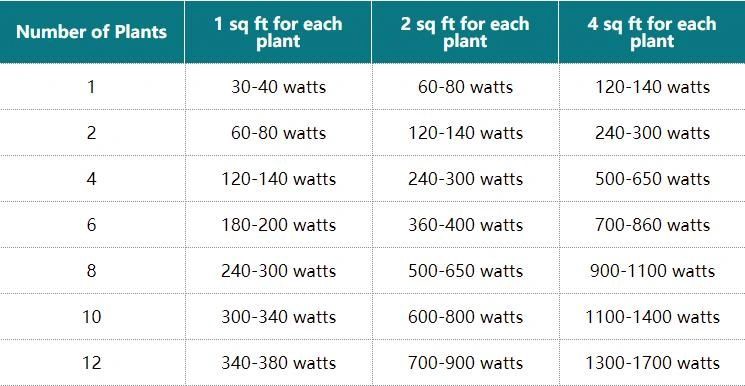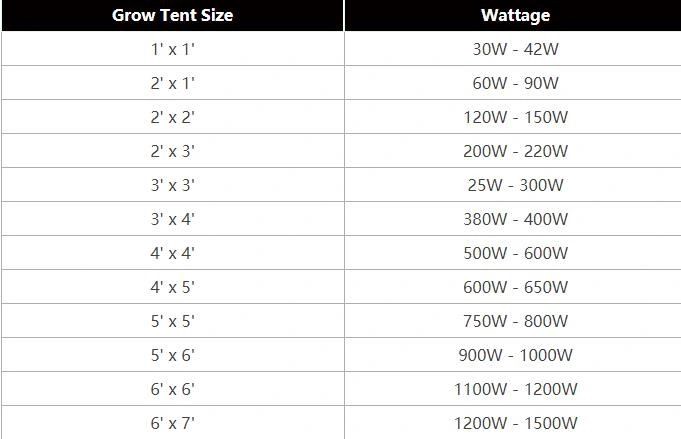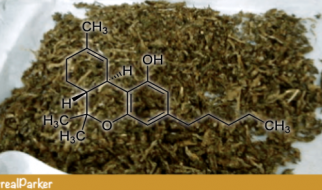Understanding PAR Output
You?ve probably heard about PAR. In simple terms, It?s the part of the light spectrum that your plants use for photosynthesis. So It?s a pretty big deal. The higher the PAR output of your light, the more edible light your plants receive. Take a look at the table below for the optimal ranges of PAR for each stage of your plans life:

Ideally, you want to pick a grow light that outputs PAR in the ranges above. This pretty much rules out any LED grow light below 300w, as they simply don?t have enough power to generate the required levels of PAR. That said, keep in mind that these are optimal levels of PAR. Using a grow light that has less PAR output than these ranges will not be a disaster, you just won?t max out the potential of your plant.
Consider The Number Of Plants You Are Growing
Sea of Green (SOG) ? 1 sq/ft per plant
Sea of Green forces plants into the flowering stage at a very early age.
In fact, after about only two weeks in the vegetative stage you?ll switch the lights to 12/12.
This forces them into flowering so soon you?re able to get more harvests per year ? which is one of the reasons people love this technique
After a canopy of buds has started to form, start trimming all the leaves, so the plant spends all of its energy into bud growth.
Screen of Green (SCROG) ? 4?6 sq/ft per plant
Screen of Green trains your plant horizontally forming these monster bushes.
If you?re limited on space, growing with SCROG is one of the best ways to make use of what you have.
It works by spreading the tops through a horizontal screen that?s placed above the plants.
Spreading the plant this way encourages bud growth on the branch stems that are normally neglected.
As the plant grows, it will reach for the screen that?s 8?12? above it.
But, instead of letting the plant grow through the holes of the screen, push the tops back through with your finger to make them grow across the screen ? try to fill all the empty space!
Induce flowering when the plant has covered 50?60% of the screen for the best result.
Topping ? 2?4 sq/ft per plant
Topping has long been a favorite of marijuana growers.
It?s easy and doesn?t require any extra setup.
If grown undisturbed, most cannabis plants will grow one huge top (known as the cola).
The idea behind topping is forcing the plant to grow more than one cola ? which translates to more bud!
To top a cannabis plant all you need to do is remove the growth tip and it will split into two more.
You can split two into four, four into eight and so on.
Topping your plants once will turn it into a cannabis bush while topping it a bunch will turn it into an inverted Christmas tree with all the growth at the top of the plant.
Once topped, plants grow sideways more then up allowing you to control the height of the plant.
Low-Stress Training (LST) ? 2 sq/ft per plant
Low-Stress Training is training your cannabis plants without the stress that topping or pruning put on the plant.
In case you didn?t know, the intensity of light from a source is inversely proportional to the square distance from the source (This is known as the Inverse-square Law of Light).
LST takes full advantage of this by slowly moving the top of the plant out of the bottoms way so it can receive more light.
More light = more bud.
You need to take your time training your plant to grow laterally, or in a circle around the pot, if you go too fast you can put too much stress on the plant.
To train it, use string or wire tied around plant branches and the planter to keep pressure on the branch while moving it where you want it to go.
Variables that play a major role in determining the number of watts you need per square foot
There are lots of factors that determine how many watts per square foot LED lights that are needed. These variables are:
Type of plants
Different plants vary when it comes to lighting needs. Some plants require more light whereas others require average light. In particular, plants with a canopy require more light so that it would penetrate beneath and, more light means more watts. Examples of high light intensity plants include tomatoes, pepper, and cannabis. Herbs, on the other hand, require average lighting.
Before you can decide on the required wattage it is essential that you first determine the lighting requirement of the plants you are to grow. Inadequate and too much light both affect the output of plants negatively, therefore, you should hit the balance.
Growth phase
Basically, plants have three growth phases germination, vegetative and flowering. In the three phases, the lighting requirements are different explaining why some of the best LED lights have an adjustment button for the various phases.
During germination, plants require less light, this increases when the plants reach the vegetative phase. Flowering is the prime high light requirement for plats. High light intensity is essential for plants to flower and produces big buds.
The number of plants
As much as you want to grow more plants in the marijuana grow tent one thing should be certain. Plants need breathing space and hence should be adequately spaced depending on the type of plants.
The number of plants in the growing area is also a variable essential that should never be ignored when determining the number of watts needed per square foot. The more the number of plants the higher the wattage requirement and vice versa!
Spectrum light
The sun has light spectrums but unfortunately, they cannot be seen with a naked eye. LED grow light full spectrum is, however, visible to the eye. In particular the red and blue spectrums are highly recommended since they are known to support flowering and vegetative.
Light reflectors
The idea of light reflectors is new to most people but this doesn?t mean that it isn?t necessary. For optimal light usage reflectors are essential. When done right, reflectors can reduce the wattage per square foot needed to maximize plant yield.
What is the essence of reflectors in a grow tent? Reflectors are essential in the sense that they reflect and concentrate light on the plants. This is particularly useful given the fact that; walls of most grow rooms are dark and the last thing you want is walls that absorb light meant for the plants.
How Many Plants And How Big LED?s?
Here?s the catch ? LED grow lights have specific wattages. For example, a certain model could have 3W, but this will easily burn out when you run the unit at 3W electric power.
You might be enticed by a certain model that brags about 600W. Yes, that?s impressive.
However, it could probably only draw about 240 to 260 watts of electricity to obtain the same effect as a 600W HPS or HID grow light.
Thus, it is best to operate LED grow lights on 60% power. This is also applicable when you follow the 4 square foot per plant rule.
But looking at this table, you?ll see that the power of a LED lighting system increases depending on the size of your grow room and plant density.

Calculating wattage requirement per square foot for LED grow lights
Among all artificial lights, LED grow lights have the highest PAR and have more lifespan. An average LED light runs for 10,000 hrs. To extend the lifespan some companies set the lights such that full capacity is not used. Some lights will be written 5 watts yet only operate on 3 watts. This, however, should not be an issue in calculating how many watts per square foot of LED grow lights since we shall highlight the average requirement per square foot.
On average for a 10 square foot grow area 400 watts is sufficient. The average wattage requirement per foot for LED grow lights is 40?50watts. This is however not standard since different LED grow lights vary some are energy efficient and will use fewer watts for the same kind of lighting. 40?50 watts is just the average standard.
The size of the LED grow light also matters if big this means that it will cover a relatively large area. A smaller grow light bulb will mean that only a small portion will be covered and hence more watts will be needed to illuminate a large area.
How Many Plants Can I Grow?
In general, each cannabis plant you grow requires at least 1sq ft of space. After germination, I like to pot one plant in a large 5 gallon fabric container, which has a diameter of roughly 1 sq foot. My plant will stay in this pot until it flowers.
This allows the plant to grow big and strong without other plants or tent walls obstructing its progress. Using this as a guideline, I would be able to grow between 1?6 plants in my example above.
Most LED grow lights usually be able to cover about 1- 6 plants. If you want to grow any more plans than this, I?d purchase multiple lights to hang side by side ( called daisy chaining ) to cover the canopy and ensure each plant is getting enough light.
The table below shows how the power of grow light you require increases with the size of your grow space. I?ve also included how many plants each size of grow light will be adequate for.
Note: 1 sq ft grow space = 50 watts LED grow light

Would The Height Of A LED Grow Light Impact The Watts?
Absolutely. However, be aware that the distance between the lights and the canopy has an impact on light intensity.
Likewise, using powerful LED grow lights and keeping them in the right distance are some of the ways to achieve bigger yields.
Remember not to keep your LED lights too close to your plants to avoid bleaching, nutrient deficiencies, sunburn, and appearance of yellow leaves.
In reality, there?s no standard distance required to place each LED grow light, but there are recommended grow light height from plants on each growth stage.
Sometimes, the distance may also depend on the model and the brand. Here?s a quick reference you could follow:

Frequently asked questions (FAQ)
How many lumens per plant led lights need?
If plants are placed at 1 plant/sq. Ft. rate, each of the plants need 30w of light energy from LED lights. If the density increases to 2 plants/sq. Ft. or 3/plants/sq. Ft., it will increase at same manner.
How many plants can I grow with a 300w led light?
It depends on how densely plants are placed, and how high the LED light is from the plant canopies. If pants are placed at 1 plant/sq. Ft. rate, you can cover up to 8 plants with a 300w LED light.
How many lights for 12 plants do I need?
If you chose to buy a 120w light for a grow space of 1 plant/sq. Ft. rate, you will need 3 lights to cover it up. If you chose to buy 180w lights, you will need two of them to serve 12 plants.
how many 600w lights for 10 plants do I need?
600w taken as the ?actual? wattage served by the light, you don?t need more than one 600w light for 10 plants, if plants are planted at 1 plant/sq. Ft. density. Even for some crops, a 600w light source can be more than what they need.


